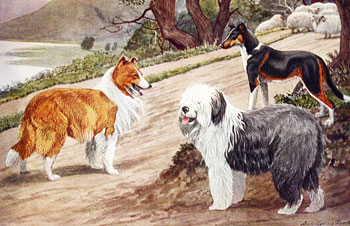Dog Breeds
Dog Tips
Training
Exercise
Medical
Interviews
Miscellaneous
About DB
Contact DB
Resources

Illustration by Louis Agassiz Fuertes
Dachshund
The dachshund, or badger dog, combines to a high degree the qualities of the hound and the terrier, and probably both of these were used in his development, but where he got his crumpled legs is less apparent. He is the favorite dog of Germany, where his special work is to enter a badger hole and hold the attention of the animal until it can be dug out.
Badgers often work serious havoc in the cultivated fields, and they can dig their way through the ground so rapidly that it is very difficult for diggers to overtake one without the use of a dog. To follow this fierce, belligerent, and really dangerous animal into his burrow and drag him out requires a dog of great courage and tenacity, not to mention peculiar design. His long body, short legs, and large, outturned fore feet subject him to much ridicule, and it is often said that in Germany he is sold by the yard.
The dachshund usually seen in this country has a short and very silky coat, but there are also a long-haired and a rough-coated variety.
The well-formed dachshund should be three times as long, from nose to base of tail, as he is high at the shoulder. The head should be long and slender, but far from snipy, the nose running smoothly into the line of the forehead, with little depression at the top, and the occiput should be evident. The hound-like ears, combined with this more terrier-like head, give him an expression all his own.
The body and neck are long, but muscular and compact, entirely free from sagginess or weakness, and the tail is the true, tapering, terrier style, as nearly straight as may be.
The legs and feet are very important. While extremely short, they must be very strong and well boned. The fore legs, while bowed and twisted somewhat, must be strong, elbows out, wrists in, and feet turned out. The hind legs are to be strong and capable, and viewed from behind must go down straight and by no means show the turning in at the heel, known as cowhocks. This is very common and very bad. The thigh, when standing, goes down nearly straight; the shank (between stifle and hock) goes straight back horizontally, and the last joint, or rear pastern, is about vertical, parallel to the thigh. The feet are large, deep, and well padded.
They are generally black and tan, revealing the terrier strain here in the persistency of this dominant color-pattern. There are strains, however, of a whole-colored dark red tan, or "cherry," or even solid brown. The last named are not considered as good, and must be excellent in other respects to be given a favorable rating with the better-known colors.
In disposition they combine to an unusual degree the virtues of their respective ancestors, having the affectionate, companionable qualities of the hound and the tenacity, courage, and self-reliance of the terrier.
Did you enjoy this article? Let us know what you think by commenting below. Don't forget to Friend us on facebook and subscribe to our twitter feed to stay updated! Thanks for reading, recommend us to your friends! |
